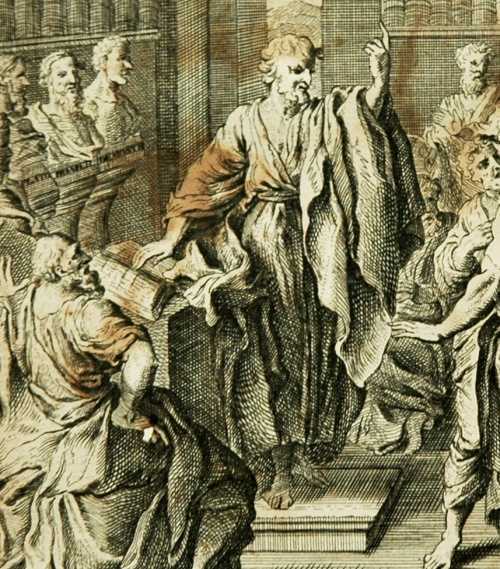Before the pandemic, before the murder of George Floyd and the others whose names we have been chanting, before even the presidential election of 2016, it already seemed, in the humanities, that it was the world and not just the job market that was falling apart. Provocative questions were being asked about whether we have maybe forgotten why we do what we do and why it is or isn’t worth doing. Truth? Beauty? Justice? In the midst of this Jonathan Arac wrote a crystalline micro-credo and put it away in his drawer. In it he sums up a life’s intellectual commitments, and does so with his usual preference for talking about other people’s lives and commitments—his usual desire to give credit where credit is being omitted. That desire being one motive for doing the job that, as he knows, he has been lucky to have, especially since history may not give the next generation the same chance to do it.
–Bruce Robbins
[The image is of Longinus.]
Aesthetics in the Discipline of Literary Study Today
Jonathan Arac
Aesthetics: I too dislike it. I much prefer poetics. See Paul Bové’s outstanding book Poetry and Torture, with chapters on Vico and Auerbach, but also John Stuart Mill and William Empson. Poetics as a term invites thinking about works of writing, or of culture more broadly, as the results of human making. What human beings have made may be studied closely in its emergence and its endurance in a historical world of human action and interaction. Here I enter the discursive vortex of Vico. Even Vico’s devoted follower Erich Auerbach characterized the tradition he derived from Vico, the practice to which he committed his own great philological works, as “Aesthetic Historism.” German bourgeois high culture, even at its very best, can’t do without aesthetics. See Adorno’s Aesthetic Theory.
In the last fifty years, the best slogan for aesthetics was Susan Sontag’s. She rejected a ‘hermeneutics of art’ for ‘an erotics of art.’ This stays close to the etymological force of aesthetic as registering sensory perception. Her own work, for perfectly good reasons, did nothing much in the way of carefully detailed analysis of the particulars of individual, specific works, whether of writing or of film. It would be ridiculous to call Richard Poirier a disciple of Sontag’s, but he may be the most academically authoritative critic to bring an erotic perspective—often stated in terms of ‘energy’–to a substantial body of critical writing that meets our pedagogical standards of attentiveness.
Poirier was a student and then colleague of Reuben Brower in the Amherst-Harvard version of close reading. This lineage claimed authority from Robert Frost. Paul de Man may never have read Frost, but de Man’s work on the staff of Harvard’s Humanities 6 changed him from a European philosophical critic, for whom aesthetics was second nature, to a practitioner of reading. The logic of close reading led him to an explicit critique of the aesthetic in the names of grammar and rhetoric.
Aesthetics is not just Greek for close reading. The term arose in the German philosophy of the eighteenth century. Its accumulations from Kant and Hegel have loaded it with claims involving “disinterestedness” and “totality.” Schoolbook deconstruction proved so pedagogically unrewarding because it kept turning into just the opposite of totalizing. Likewise schoolbook demystification, because the interests it reveals are so boring.
Matthew Arnold contained within himself the yes and the no of disinterest. This is one reason we can’t get away from Arnold. His claim for disinterestedness led to the injunction that critics must see our object ‘as in itself it really is’. As teachers, we cannot escape some version of that. Yet Arnold moves from Kantian objectivity to a naturalism in the name of Goethe. Arnold praised Goethe for always asking, “But is it so? Is it so to me?’. Arnold already contained Pater.
I have praised poetics, but I don’t always follow its maker. Aristotle makes too strong a case for unity and wholeness. I may be happiest with aesthetics when it lets me choose Longinus against Aristotle. I. A. Richards follows Aristotle to seek stable poise, the “reconciliation of opposites” that Coleridge bequeathed to our critical handbook. Longinus names sublime the moment of perceptual overload. The sublime knocks your socks off. It’s ‘ekstasis’, the out-of-placeness that shatters the poise of the individual perceiver or reader and also the smooth texture of the work. The rough erotic in Longinus operates sadomasochistically. Humanities 6 and Longinus agree that critical reading begins with the obligation to find where in the text something is going on.
Longinus didn’t even quote the whole of an ode by Sappho. Epics and novels are too big for critics to show in their totality. Cleanth Brooks and Robert Penn Warren made it possible for anyone to learn to write a hundred and forty lines of critical prose to demonstrate the complex unity of a fourteen-line sonnet. Close reading means an expansion by ten, but no one has yet written a five thousand page book on Moby-Dick. It’s way bigger than the case anyone can make for its unity. The joke of Barthes’s S/Z came in accomplishing such a scale-up at least for a novella. Henry James and Percy Lubbock and Virginia Woolf experimented with metaphors for the total shape or atmosphere of particular novels, but Georg Lukács abstractly characterized the dissonance of the form. The practice of symptomatic reading developed to flesh out this abstraction, and it remains, I think, an essential.
Symptomatic reading is less erotic than hermeneutic, and that a hermeneutics of suspicion. Auerbach’s Mimesis reads lovingly. His tact diminishes the violence of decoupage, the scissoring up the page to extract the quoted passage, the cutting room floor where the rest of the text falls. His humanistic love also enacts violence. Who can believe that Dante would have accepted Auerbach’s conclusion: “the image of man eclipses the image of God”? Dante’s newly achieved high style shatters the commonplace verities of his religion, or Auerbach’s critical chutzpah makes mincemeat of Dante’s construction. Is it so, is it so for me?
Once perception is unbounded from Kantian consensus, the problem returns that New Criticism was designed to solve. The egoistic prowess of impressionist criticism was unsuitable for mass democratic classrooms. Submission to the authority of the poem itself promised, for Richards, to harmonize our impulses and protect us from propaganda. Learning to read what the poem is, freed from stock responses, trains a reader to see though anything less whole, that is more partial, than a poem. That was fine, until the Cold War sought conformity over mobilization. The anti-aesthetic position then developed to argue that no, the poem, and the ideology of the poem, that’s the propaganda. The super-aesthetic position enhances the reader’s perceptions to the point that sublimities explode, but for different people at different points in the text. As they say in Henry James, well, there we are.


